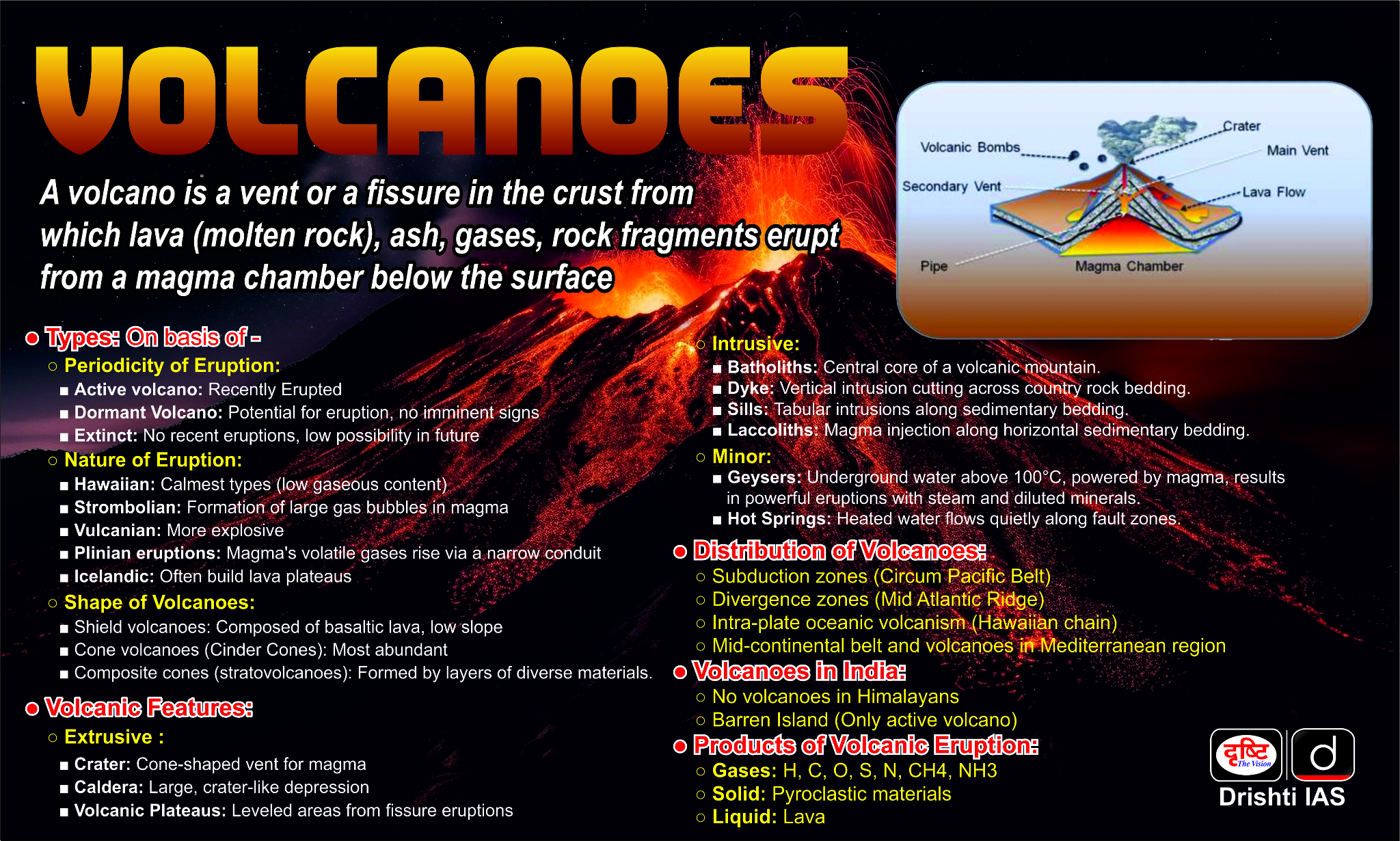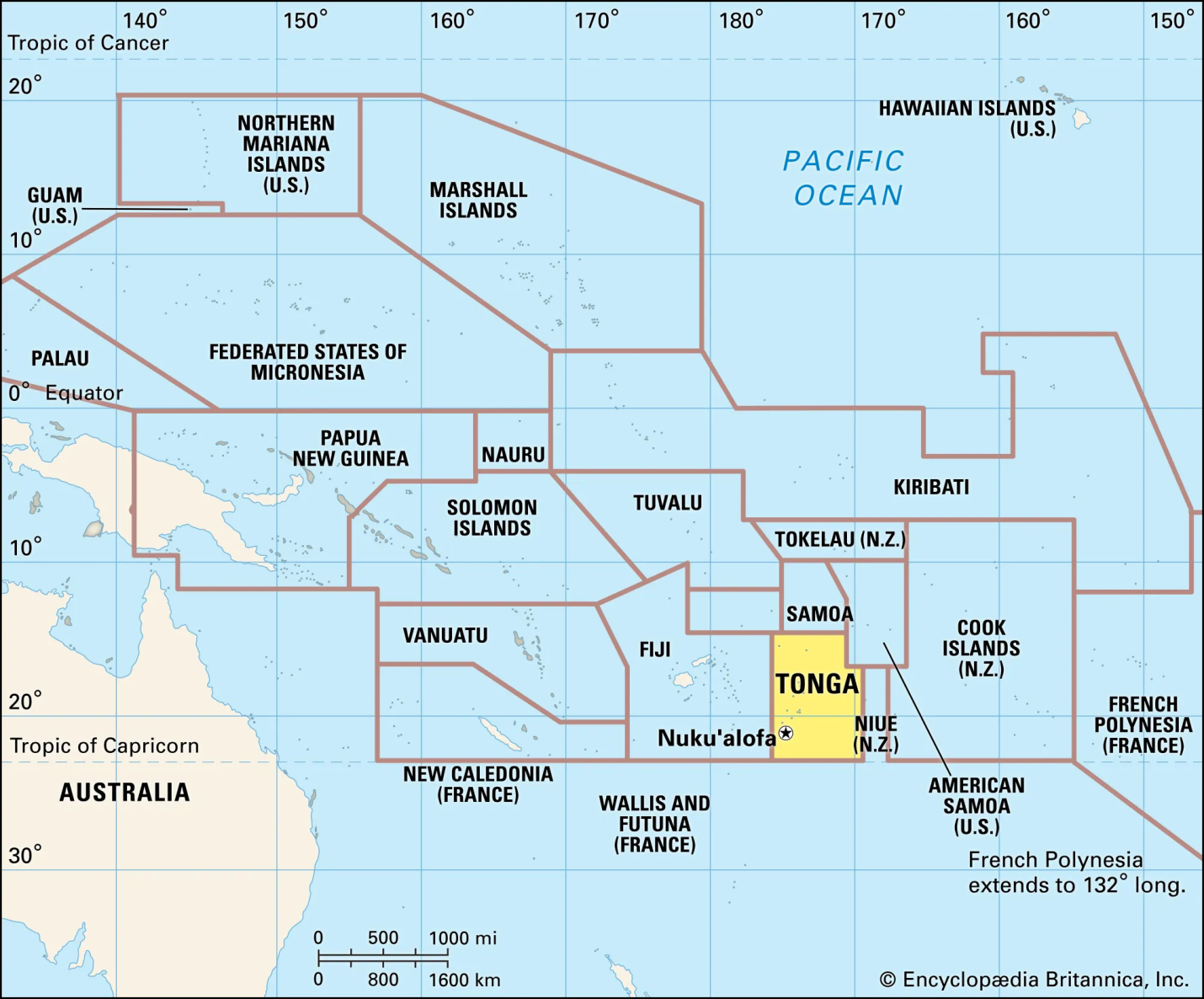Geography
Tonga Volcano Impacting Weather
- 05 Jun 2024
- 8 min read
For Prelims: Hunga Tonga-Hunga Ha'apai, Pinatubo, Krakatoa, Tambora, Samalas, Greenhouse Gases, El - Nino, Paris Agreement, IPCC, Cooling credits, Sun dimming.
For Mains: Effect Of Volcano On Global Warming, Types of volcano
Why in News?
A recent study published in the Journal of Climate revealed that the eruption of the Hunga Tonga-Hunga Ha’apai Volcano in January 2022 has had significant implications for global weather patterns.
Hunga Tonga-Hunga Ha’apai Volcano
- It is an Undersea Volcanic Eruption consisting of two small uninhabited islands, Hunga-Ha’apai and Hunga-Tonga.
- The volcano has erupted regularly over the past few decades.
- This is one of the massive explosions the volcano is capable of producing roughly every thousand years.
- One of the reasons for it being highly explosive is the Fuel-Coolant interaction.
- The Hunga Tonga eruption's unique characteristic of injecting massive water vapour into the stratosphere.
- Usually, volcanic smoke, which mostly contains sulphur dioxide, leads to a temporary cooling of the Earth's surface.
- The sulphur dioxide turns into sulphate aerosols, which reflect sunlight into space, causing the surface to cool down until the sulphate settles back on the surface or is washed out by rain.
- Usually, volcanic smoke, which mostly contains sulphur dioxide, leads to a temporary cooling of the Earth's surface.
What are the Effects of the Hunga-Tonga Volcano on the Climate?
- Extraordinary Ozone Hole in 2023:
- Since, Hunga Tonga is an underwater volcano, it produced 100-150 million tonnes of water vapour during its eruption, raising the amount of water in the stratosphere by around 5%.
- This water vapour in the stratosphere contributes to the destruction of the ozone layer and acts as a potent greenhouse gas.
- The study found that the large ozone hole observed from August to December 2023 was at least partly due to the Tonga eruption.
- This ozone hole was almost two years in advance, as the water vapour from the eruption had enough time to reach the polar stratosphere over Antarctica.
- Since, Hunga Tonga is an underwater volcano, it produced 100-150 million tonnes of water vapour during its eruption, raising the amount of water in the stratosphere by around 5%.
- Wet Summer of 2024 in Australia:
- The study predicted a positive phase of the Southern Annular Mode during the summer of 2024, leading to a higher chance of a wet summer in Australia.
- This was contrary to the expected El Niño conditions.
- Regional Weather Disruptions:
- The study predicts colder and wetter than usual winters for the northern half of Australia up to around 2029.
- North America may have warmer than usual winters, while Scandinavia can have colder than usual winters.
- These regional weather patterns are attributed to the Tonga eruption's impact on the way atmospheric waves travel, which directly influences local weather conditions.
- This emphasises the need for region-specific climate predictions and adaptation strategies.
- Minimal Impact on Global Temperatures:
- The impact of the eruption on global mean temperatures was very small, around 0.015°C.
- The incredibly high temperatures observed for about a year cannot be attributed to the Tonga eruption.
Undersea Volcano
- The undersea volcanic eruption happens in a volcano which is located under the ocean surface. There are an estimated one million undersea volcanoes, and most of them are located near the tectonic plates.
- Apart from lava, these openings also spew out ash. These deposit on the ocean’s floor and lead to the formation of sea mounds (underwater mountains that are formed on the ocean floor but do not reach the water surface).
Fuel-Coolant Interaction
- If magma rises into seawater slowly, even at temperatures of about 1200 degrees Celsius, a thin film of steam forms between the magma and water. This provides a layer of insulation to allow the outer surface of the magma to cool. But this process doesn’t work when magma is blasted out of the ground full of volcanic gas.
- When magma enters the water rapidly, any steam layers are quickly disrupted, bringing hot magma in direct contact with cold water. It is akin to weapons-grade chemical explosions.
- Extremely violent blasts tear the magma apart.
- A chain reaction begins, with new magma fragments exposing fresh hot interior surfaces to water, and the explosions repeat, ultimately jetting out volcanic particles and causing blasts with supersonic speeds.
Tonga
- Tonga is an island country in Polynesia, part of Oceania, with 171 islands, of which 45 are inhabited.
- The country spans approximately 800 km north-south and is surrounded by Fiji, Wallis and Futuna, Samoa, New Caledonia, Vanuatu, Niue, and Kermadec.
- Tonga has a tropical rainforest climate. The economy relies heavily on remittances from Tongans living abroad, particularly in Australia, New Zealand, and the United States.
- The economy focuses on small-scale industries like handicrafts and agriculture, with efforts to enhance sectors such as tourism and communications.
- The largest ethnic group in Tonga is Tongan, followed by a mix of Tongans, Chinese, Fijians, Europeans, and other Pacific Islanders.
|
Drishti Mains Question: Discuss the factors leading to volcanic eruptions. Also, suggest mitigation strategies for managing volcanic hazards in India. |
UPSC Civil Services Examination, Previous Year Question (PYQ)
Prelims
Q. Consider the following: (2013)
- Electromagnetic radiation
- Geothermal energy
- Gravitational force
- Plate movements
- Rotation of the earth
- Revolution of the earth
Which of the above are responsible for bringing dynamic changes on the surface of the earth?
(a) 1, 2, 3 and 4 only
(b) 1, 3, 5 and 6 only
(c) 2, 4, 5 and 6 only
(d) 1, 2, 3, 4, 5 and 6
Ans: (d)
Mains:
Q. Discuss about the vulnerability of India to earthquake related hazards. Give examples including the salient features of major disasters caused by earthquakes in different parts of India during the last three decades. (2021)
Q. Why are the world’s fold mountain systems located along the margins of continents? Bring out the association between the global distribution of fold mountains and earthquakes and volcanoes. (2014)
Q. Mention the global occurrence of volcanic eruptions in 2021 and their impact on regional environment. (2021)







